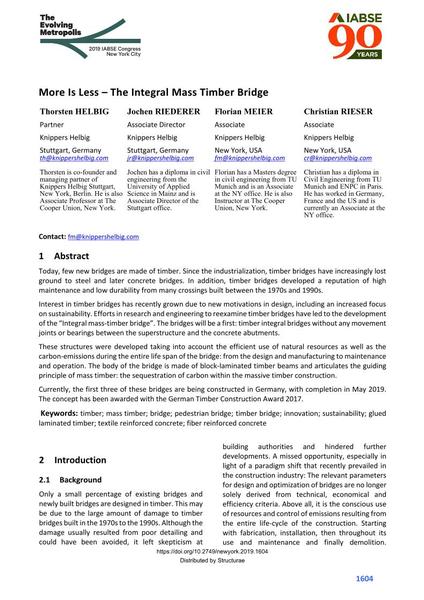More Is Less – The Integral Mass Timber Bridge

|
|
|||||||||||
Bibliografische Angaben
| Autor(en): |
Thorsten Helbig
(Knippers Helbig)
Jochen Riederer (Knippers Helbig) Florian Meier (Knippers Helbig) Christian Rieser (Knippers Helbig) |
||||
|---|---|---|---|---|---|
| Medium: | Tagungsbeitrag | ||||
| Sprache(n): | Englisch | ||||
| Tagung: | IABSE Congress: The Evolving Metropolis, New York, NY, USA, 4-6 September 2019 | ||||
| Veröffentlicht in: | The Evolving Metropolis | ||||
|
|||||
| Seite(n): | 1604-1612 | ||||
| Anzahl der Seiten (im PDF): | 9 | ||||
| DOI: | 10.2749/newyork.2019.1604 | ||||
| Abstrakt: |
Today, few new bridges are made of timber. Since the industrialization, timber bridges have increasingly lost ground to steel and later concrete bridges. In addition, timber bridges developed a reputation of high maintenance and low durability from many crossings built between the 1970s and 1990s. Interest in timber bridges has recently grown due to new motivations in design, including an increased focus on sustainability. Efforts in research and engineering to reexamine timber bridges have led to the development of the “Integral mass-timber bridge”. The bridges will be a first: timber integral bridges without any movement joints or bearings between the superstructure and the concrete abutments. These structures were developed taking into account the efficient use of natural resources as well as the carbon-emissions during the entire life span of the bridge: from the design and manufacturing to maintenance and operation. The body of the bridge is made of block-laminated timber beams and articulates the guiding principle of mass timber: the sequestration of carbon within the massive timber construction. Currently, the first three of these bridges are being constructed in Germany, with completion in May 2019. The concept has been awarded with the German Timber Construction Award 2017. |
||||
| Stichwörter: |
Brücke Nachhaltigkeit Fußgängerbrücke Innovation TRC
|
||||
